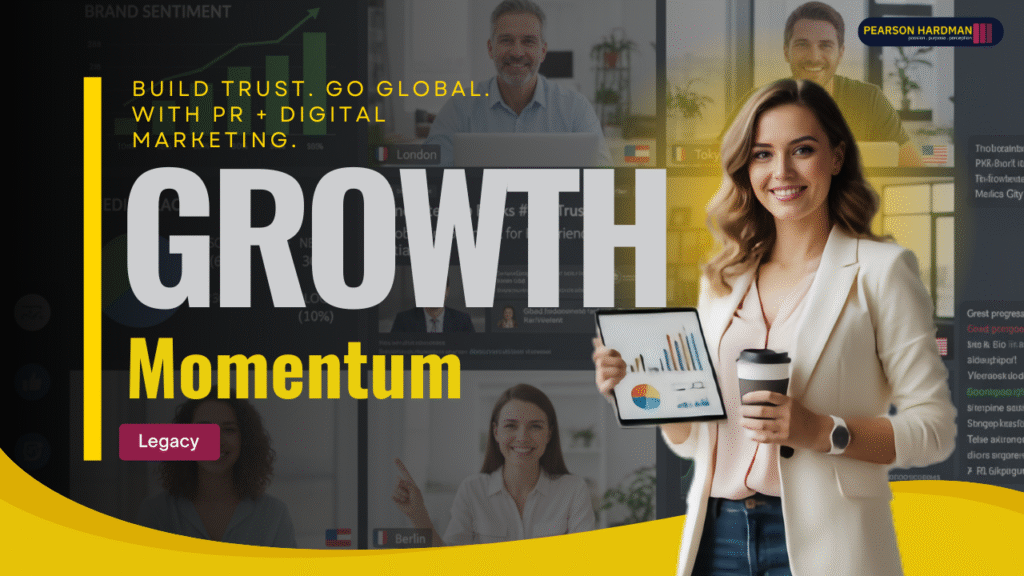Introduction
If you ask any successful business leader what really makes a brand grow, the answer won’t just be sales numbers, advertising budgets, or even innovation. The real foundation of growth is trust. Customers today are not only buying a product or service—they are buying the promise that a brand represents. And the truth is, trust doesn’t come overnight; it’s carefully built through consistent communication, authentic storytelling, and visible credibility.
This is exactly where Public Relations (PR) and Digital Marketing step in. For years, PR and digital marketing worked in silos—PR focused on shaping how people perceive a brand through media, while digital marketing focused on generating online visibility, leads, and measurable results. But businesses that are thriving today, whether in Pune, London, or New York, are the ones who realized that combining these two disciplines creates something far more powerful: trusted visibility.
This article dives deep into how integrating PR with digital marketing not only helps businesses stand out but also creates a reputation strong enough to attract global audiences.
Why Brand Trust Is the New Currency
Trust has become the global currency for businesses. Without it, even the most innovative idea can fail. Think about it—when you consider buying from a new brand, do you check what they claim about themselves, or do you look for outside validation? Most people head to Google, check reviews, look for media coverage, or notice whether industry experts are talking about the company. That validation, especially when it appears in multiple credible places, becomes the deciding factor.
In India, for instance, local businesses know that customers read online reviews and news mentions before making decisions. In the United States, companies are scrutinized for transparency, leadership visibility, and corporate responsibility. In Europe, authenticity and strict compliance with data protection laws are key to gaining consumer trust. Even in emerging hubs like Pune or Bangalore, startups find themselves competing not only locally but also with global players, and one of the fastest ways to level that playing field is to combine PR’s credibility with the reach of digital marketing.
The common thread worldwide is clear: when people see the same brand story repeated across respected media outlets, optimized blogs, LinkedIn campaigns, and even casual social media mentions, they start believing in the brand’s reliability. That’s what builds long-term loyalty.
Understanding PR and Digital Marketing: Different Tools, Same Mission
Public Relations and Digital Marketing often feel like separate worlds, but at their core, both are working toward the same mission—to build influence and trust for the brand. The difference lies in how they do it.
Public Relations (PR):
PR is essentially the art of reputation building. It is about ensuring your company is talked about in the right places by the right people. This could mean coverage in newspapers, features in business magazines, interviews with industry leaders, or managing your brand’s presence during a crisis. When a brand is quoted in a respected publication, it carries a sense of authority that no paid advertisement can replicate.
Digital Marketing:
Digital marketing is more measurable and targeted. It ensures your brand is visible where customers spend most of their time—search engines, social media, email inboxes, and video platforms. Whether it’s through SEO, pay-per-click ads, Instagram reels, or LinkedIn thought-leadership posts, digital marketing delivers the message directly to your audience and tracks how they respond to it.
Why Integration Matters:
On its own, PR builds credibility, but it may not always guarantee reach. On its own, digital marketing gives you reach, but without credibility, it risks sounding like just another ad. Together, however, PR and digital marketing reinforce each other. PR validates your brand, and digital makes sure that validation is seen by thousands or even millions of people, globally.
How PR + Digital Marketing Builds Global Trust
When integrated well, PR and digital marketing don’t just create visibility; they create consistency across every touchpoint where a potential client or customer interacts with your brand. Here’s how:
-
Credibility with Longevity: A single press article may appear and fade away, but when that same article is optimized for SEO and shared across LinkedIn or Twitter, it becomes evergreen. Years later, someone searching for your brand can still find that validation.
-
Local + Global SEO Advantage: Imagine your business issues a press release optimized for “digital PR agency in Pune.” Locally, it helps you rank and attract nearby clients. But when you also create content around “global PR and digital marketing services,” international prospects find you as well. It’s a double advantage.
-
Consistency Across Platforms: Today’s consumer doesn’t just interact with you on one channel. They may read about you in a magazine, then Google you, then check your LinkedIn. If your story is consistent in all those places, it naturally creates trust.
-
Amplification Through Influencers and Media: Journalists bring credibility, influencers bring relatability. When PR earns you a spot in a news outlet and digital campaigns push that same coverage through influencers, the trust factor multiplies.
-
Measurable Trust-Building: Unlike traditional PR, digital allows you to measure exactly how many people saw your article, clicked your post, or signed up because of your coverage. This makes trust a measurable business asset.
Case Study: Global Integration in Action
Example 1: Emerging Market – A SaaS Startup in Pune
Picture a SaaS startup based in Pune that has just raised a fresh round of funding. They release a press announcement, which gets covered by national business media. Instead of letting the story live only in print or online news archives, the company promotes the coverage on LinkedIn and targets digital ads at investors in Singapore and Dubai. Suddenly, what started as a local PR story becomes a global talking point. Investors outside India now view the brand as credible because the media endorsement is combined with smart, data-driven promotion.
(This is a hypothetical illustration inspired by real patterns we see in Indian startup ecosystems.)
Example 2: International Market – A Consulting Firm in New York
Now imagine a global consulting firm headquartered in New York. The firm publishes a thought-leadership piece in a respected international journal. Rather than relying on the journal’s readership alone, they repurpose the content into SEO-optimized blog posts, turn it into a podcast episode, and launch targeted LinkedIn ads showcasing the feature. The credibility from being published in a trusted outlet, combined with the reach of digital, brings in new clients not only from the US but also Europe and Asia.
(This is a generalized scenario inspired by industry best practices globally.)
Practical Strategies to Apply Integration
For businesses aiming to grow, whether in local hubs or global markets, here are some actionable steps:
-
Create a Unified Story – Your press release, blog, ad copy, and social post should all tell the same narrative about who you are.
-
SEO Every PR Effort – Don’t just release news; optimize it with relevant keywords that make it discoverable long after the initial buzz fades.
-
Balance Global and Local – Mix global insights with localized campaigns to attract both international and city-specific clients.
-
Combine Influencers with Journalists – Traditional media and influencers may speak to different audiences, but together they reinforce credibility.
-
Measure Everything – Use tools like Google Analytics or SEMrush to track how PR stories amplified digitally are converting into real leads.
Challenges Businesses Face
Of course, integrating PR and digital marketing isn’t without challenges. Budget allocation can be tricky—should you spend more on paid campaigns or media relations? Cultural differences across markets mean what works in India might not resonate in Europe. And while digital is easy to measure, PR’s impact is sometimes harder to quantify. But when combined thoughtfully, even these challenges become opportunities, because the strengths of one discipline balance the weaknesses of the other.
The Future of PR + Digital Marketing
Looking ahead, PR and digital marketing will only get more intertwined. Artificial Intelligence will make it easier to track global coverage in real time. Hyper-local campaigns in regional languages will exist alongside global campaigns aimed at Fortune 500 companies. Micro-influencers will continue to grow in influence, making them as valuable as mainstream media mentions.
For agencies like Pearson Hardman, the opportunity lies in being able to serve businesses across geographies with strategies that are locally relevant yet globally scalable.
Conclusion
At the end of the day, the brands that succeed are the ones that are trusted. PR alone can give you credibility, but it may not always reach the right people. Digital marketing alone can give you reach, but without credibility, it can look like just another ad. Together, they create something unique—trusted visibility.
Whether you’re a startup in Pune trying to attract global investors, or a multinational in New York trying to maintain thought-leadership worldwide, integrating PR with digital marketing is no longer optional—it’s essential. If you want long-term growth, don’t just chase visibility. Build credibility, amplify it digitally, and turn trust into your strongest competitive advantage.





